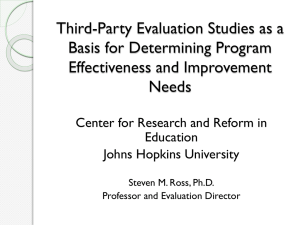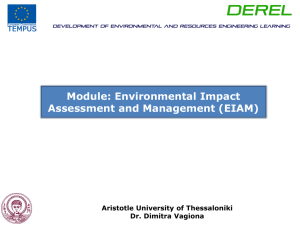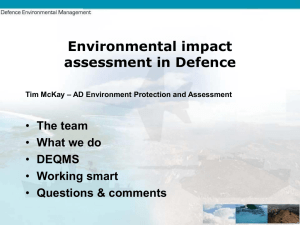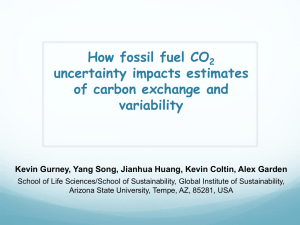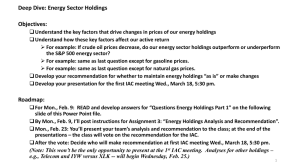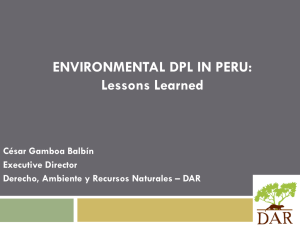EIA Study and Report Preparation
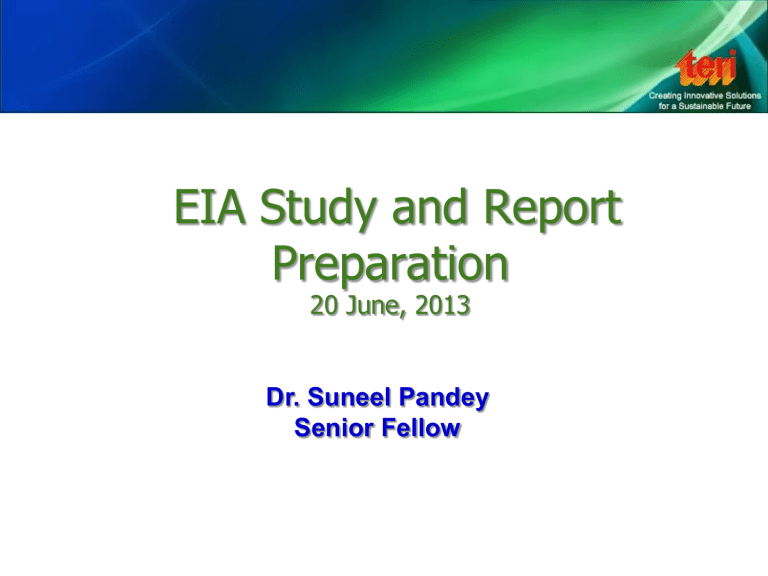
EIA Study and Report
Preparation
20 June, 2013
Dr. Suneel Pandey
Senior Fellow
EIA as an Environmental
Management Tool
Environmental Impact Assessment
(EIA) - Introduction
• An assessment of the impact of a planned activity on the environment”
• EIA is a planning tool used to predict and evaluate the potentially significant impacts of proposed action and provide a mitigation plan for minimizing adverse impacts for making decision on the proposed project/ program/policy
• Rio principle 17 states
“EIA as national instrument, shall be undertaken for the proposed activities that are likely to have a significant adverse impact on the environment and are subject to a decision of a competent national authority”
EIA – A Tool for Sustainable
Development
• EIA - Tool for integrating objectives of environmental management into decision making process.
• Environmental (Protection) Act 1986, empowered Central
Government to introduce requirement of formal EIA procedure prior to clearance for the projects likely to have significant environmental impacts.
• Notable(& most important) feature of EIA notification was to treat EIA process as “Statutory requirement” rather than an
“Administrative requirement” .
EIA/EC Process in India
• 1978 - Hydro projects, thermal power projects were subjected to environmental assessment
• 1980-1994 - DoE/MoEF was doing all projects requiring
PIB approval
• EIA for environmental clearance was made mandatory in
1994 under E (P) Act
• 1994-2006 - MoEF listed 32 category of listed projects including private investments
• Earlier only MoEF was assigned the responsibility of the appraisal of projects for EIA Clearance
Identified Constraints in EC Process under EIA Notification, 1994
• Cumbersome procedure
• Disproportionate details sought with applications
• Delay in appraisal meetings
• Time consuming and requiring undue effort
• Reopening of technical issues during various stages of appraisal
• Poor quality of EIA studies by consultants
• Delays by other concerned agencies
Ownership of EIA Report &
Other Documents by the
Project Proponent
(MoEF OM Dated Dec. 5 th , 2011)
Violation of EPA/EIA/CRZ
Notification
(MoEF OM Dated Nov. 16 th , 2010)
Steps to be Followed in EIA
Study/EC Process
EIA
Network
EIA Methodology -
Preparation of EIA/EMP Report
• Screening
• Scoping
• Baseline Data Collection
• Prediction of Impacts
• Evaluation of Impacts
• Environmental Management Plan (EMP)
• Post Project Monitoring (PPM)
• Public hearing
Steps to be Followed in EIA
Study/EC Process
• Whether Project Requires Environmental Clearance (EC) ( As per EIA
Notification (2006) as amended till date?
• Whether it is NH/SH Project /or Expansion Project in Hilly Area above
100m MSL?
• What is the Category of Project ( Category “A” or “B”)?
• Whether EC will be Provided by MoEF (As Category “A” or Category “B”
Project due to absence of duly constituted SEIAA?
• Whether “GC” Applies or Not?
• Whether they Require Forest/Wildlife/CRZ Clearance Also ?
• What are existing MoEF provisions/rules/procedures?
• If EC (As Per EIA Notification) is Required Along with other
Environmental Clearances?
Contd …
• Depending Upon the Answers, we know that What Clearances have to obtained and where we have to approach for EC & Submit Duly Filled
Form 1 with Pre-Feasibility Report (or DPR as required) along with
Proposed ToR to the Concerned EAC of MoEF/SEIAA
• For Other “Clearances” Separate Forms Have to be Filled as per the
Prescribed Proforma
• EAC Prescribes additional ToR depending on project setting/description
& environmental setting
• If project involves Forest Clearance – Ensure that a formal request in
Prescribed Proforma has been made to Concerned State Government/
Forest Deptt. for Stage –I Clearance
• If it involves “Wildlife Clearance” – Separate Form has to be Submitted –
Before the ToR Stage
Steps to be Followed in EIA
Study/EC Process- Contd.
• Carryout EIA Study as per ToR and additional ToR provided to project proponent
• Generally public hearing is mandatory except for projects which do not require additional land acquisition
• Conduct PH (coordinated by concerned SPCB) in affected districts as per the specified procedure (based on Draft EIA
Report)
• Include comments/clarifications in Final EIA Report
• Present the Final EIA Report to EAC
• Provide Clarifications (If Sought by EAC)
• If the project require Forest Clearance, Stage-I clearance must be available with project proponent
Generic Structure of EIA Report as per
S. NO.
1.
EIA Notification, 2006
EIA STRUCTURE
Introduction
CONTENTS
Purpose of report; Identification of project & project proponent; Brief description of nature, size, location and importance of project to country, region; Scope of study – details of regulatory scoping carried out (As per Terms of Reference)
2.
Project Description Condensed description of those aspects of the project likely to cause environmental effects. Details of the following: Type of project; Need for the project; Location (maps showing general location, specific location, project boundary & project site layout); Size or magnitude of operation;
Proposed schedule for approval and implementation; Project description. Including drawings showing project layout, components of project etc. Schematic representations of the feasibility drawings which give information important for EIA purpose; Description of mitigation measures to meet environmental standards, environmental operating conditions,
3.
4.
Description of the
Environment
Anticipated Environmental
Impacts & Mitigation
Measures
Study area, period, components & methodology; Establishment of baseline for valued environmental components, as identified in scope; Base maps of all environmental components
Details of Investigated Environmental impacts due to project location, possible accidents, project design, project construction, regular operations, final decommissioning or rehabilitation of a completed project; Measures for minimizing adverse impacts identified; Irreversible &
Irretrievable commitments of environmental components Assessment of significance of impacts; Mitigation measures
5.
6.
Analysis of Alternatives
(Technology& Site)
Environmental Monitoring
Program
In case, scoping exercise results in need for alternatives: Description of each alternative; Summary of adverse impacts of each alternative;
Mitigation measures proposed for each alternative and; Selection of alternative
Technical aspects of monitoring the effectiveness of mitigation measures
7.
8.
Additional Studies
Project Benefits
9.
Environmental Cost Benefit
Analysis
10.
EMP
11 Summary & Conclusion
Public Consultation; Risk assessment; Social Impact Assessment.; R&R Action Plans
Improvements in physical infrastructure; Improvements in social infrastructure; Employment potential –skilled; semi-skilled and unskilled;
Other tangible benefits
If recommended at the Scoping stage
Description of administrative aspects of ensuring that mitigative measures are implemented & their effectiveness monitored, after approval of the EIA
Overall justification for implementation of project; Explanation of how, adverse effects have been mitigated
12.
Disclosure of Consultants
Engaged
The names of the Consultants engaged with their brief resume and nature of Consultancy rendered
Screening/Threshold Criteria for Road/
Highway Project as per EIA Notification 2006
(Amendments)
Project or Activity Category With Threshold
Limit
Category
Threshold Limit
With Condition, if any
A
7 (f) Highways i) New National Highways; and ii) Expansion of
National Highways greater than 30km involving additional right of way greater than 20m involving land acquisition and passing through more than one State.
B
(i) All New State
Highways Project; and
(ii) State Highway expansion project in Hilly
Terrain (above 1,000 m
AMSL) and or ecologically sensitive areas
General Conditions shall apply, any project or activity specified in category
“B” will be treated as Category A, if located in whole or in part within 10km from the boundary of:
i) Protected Areas notified under the
Wildlife (Protection) Act, 1972
ii) Critically Polluted areas as identified
by the Central Pollution Control Board from time to time,
iii) Notified Eco- sensitive areas by MoEF iv) inter-state boundaries and international boundaries
Note: Highways include expressways.
Guidelines of World Bank on the requirements of the Contents of an EIA report
• Executive Summary
• Policy, Legal, Institutional Framework
• Project Description
• Baseline Data
• Environmental Impact Analysis
• Cost/Benefit Analysis
• Analysis of Alternatives
• Mitigation Plan
• Institution Building
• Environmental Monitoring Plan
• Consultation
• High
• High
• High
• High
• High
• Low
• High
• High
• High
• High
• High
Guidelines of European Bank for
Reconstruction & Development (EBRD) on the requirements of the Contents of an EIA report
• Executive Summary
• Policy, Legal, Institutional Framework
• Project Description
• Baseline Data
• Environmental Impact Analysis
• Cost/Benefit Analysis
• Analysis of Alternatives
• Mitigation Plan
• Institution Building
• Environmental Monitoring Plan
• Consultation
• High
• High
• High
• High
• High
• Low
• High
• High
• High
• High
• High
Guidelines of Asian Development Bank (ADB) on the requirements of the Contents of an EIA report
• Executive Summary
• Policy, Legal, Institutional Framework
• Project Description
• Baseline Data
• Environmental Impact Analysis
• Cost/Benefit Analysis
• Analysis of Alternatives
• Mitigation Plan
• Institution Building
• Environmental Monitoring Plan
• Consultation
• High
• High
• High
• High
• High
• High
• High
• High
• High
• High
• High
Guidelines of MoEF on the requirements of the
Contents of an EIA report
• Executive Summary
• Policy, Legal, Institutional Framework
• Project Description
• Baseline Data
• Environmental Impact Analysis
• Cost/Benefit Analysis
• Analysis of Alternatives
• Mitigation Plan
• Institution Building
• Environmental Monitoring Plan
• Consultation
• High
• High
• High
• High
• High
• Low
• Low
• High
• Low
• High
• Low
Characteristics of an EIA Report
Emphasis on four aspects: a) Layout b) Presentation c) Content and d) Summary
Brief description of Content
• Introduction
• Project Description
• Alternatives
• Baseline Environment
• Impact Identification
• Evaluation and Prediction of Impacts
• Environmental Management and Monitoring Plan
Baseline Data Collection
Points to Be Considered for
Baseline Data Generation
• Improvement in the approach to select the monitoring network
• Improvement in the approach to design the monitoring network
• Improvement in the quality of Baseline data
• Development of standardized data base format
• Creation of a national data bank on environmental quality using GIS as a tool.
Baseline Data Collection
•Primary Data ( Actual On-Field Collection) and/or
•Secondary Data (From Reliable/Authentic Sources )
• Air Quality (Along with Meteorological Parameters)
• Noise
• Water Environment ( Ground & Surface)
Quality & Quantity Assessment
• Flora & Fauna
• Socio-Economic
All Information are to collected within 10Km / CoI for Road & Highway Projects
Ambient Air Quality Standards
National Ambient Air Quality Standards,
2009
* Annual Arithmetic
Mean of minimum
104 measurements in a year taken twice a week 24 hourly at uniform interval.
**24-hourly/8-hourly values should be met
98% of the time in a year. However, 2% of the time, it may exceed but not on the two consecutive days.
Ambient Noise Standards
Ambient Air Quality Standards in Respect of
Noise
Limit in dB(A) Leq
Category of Area
Industrial Area
Day time
75
Night time
70
Commercial Area
Residential Area
Silence Zone
65
55
50
55
45
40
• Day Time: 6 am to 10 pm
• Night time:10 pm to 6 am
• Silence zone: Areas upto 100 m around premises such as hospitals, educational institutions and courts.
• The Silence zones are to be declared by the Competent Authority
Environmental Management Plan
(EMP)
Elements of EMP
• Avoid adverse impacts as far as possible by use of preventative measures (Impact Avoidance)
• Minimize or reduce adverse impacts to ‘as low as practicable’ levels (Impact Minimization)
• Remedy or compensate for adverse residual impacts which are unavoidable and cannot be reduced further
(Impact Compensation)
Phases of EMP
• Pre-Construction /Design Stage/Phase
• Construction Phase (Including Site Clearing Operations)
• Operation
• Environmental Issues may vary in New Project (Greenfield) as compared to up-gradation/widening road/highway project
(depending on project & environmental setting)
• EMP may also accordingly vary
Issues to be covered/addressed in
EMP
• Applicable Environmental Laws
• Ways & means to ensure compliance of Environmental Laws
/Rules/Regulations
• Identification/Delegation of the responsibilities to ensure compliance
• Special emphasis on
• Availability of raw materials (water, sand, aggregate, soil, fly ash, etc.) (quality, quantity & identification of their sources)
• Tree cutting
• Construction of bye-passes (effect due to acquisition of prime agricultural land
Issues to be Covered/Addressed In
EMP- Contd.
• Compliance of various IRC Guidelines MoRTH
Specifications to be ensured
• Road safety considerations are integral part of EIA/EMP
Report
• Detailed Environmental Monitoring Programme/Budget for
EMP has to be indicated in the EMP
Public Hearing Related Issues
28 th.
Sept.11- OM Public Hearing
• PHs shall be supervised by DM/District Collector/Dy. Commissioner or their representative (not below ADM), assisted by SPCB/ UTPP Representative.
• Date, time and venue postponement shall not be undertaken
• If done due to Exceptional Circumstances, Postponement shall be displayed and notified to the public
• Fresh dates to be taken and notified by SPCB/UTPCC member secretary and DM/ DC/
Deputy Commissioner
Presentation before Appraisal
Committee for Prior EC
Self-evaluation of Quality and
Adequacy of EIA report
• Readability • Write Clearly
• Remove all ambiguities
• Avoid use of technical/jargon; all technical terms should be clearly explained.
Self-evaluation of Quality and
Adequacy of EIA report
• Consideration and focus
• Do not slant or misinterpret findings
• Avoid confusion or mix-up among economic, environmental, and ecological impacts and productivity
• Avoid generalities unsubstantiated
• Avoid conflicting statements
Self-evaluation of Quality and
Adequacy of EIA report
• Presentation • Use well-defined, acceptable, qualitative terms
• Quantify factors, effects, uses and activities that are readily amenable to quantification.
Self-evaluation of Quality and
Adequacy of EIA report
• Data • Identify all sources
• Use up-to-date data
• Use field data programmes as necessary collection
• Use technically approved data collection procedures
• Give reasons for use of unofficial data.
Self-evaluation of Quality and
Adequacy of EIA report
• Methods and
Procedures
• Use quantitative estimation procedures, techniques and models for arrival at the best estimates.
• Identify and describe all procedures and models used
• Identify sources of all judgments
• Use procedures and models acceptable by professional standards.
Self-evaluation of Quality and
Adequacy of EIA report
• Interpretation of Findings
• Consider and discuss all impact areas before any are dismissed as not applicable.
• Analyse controversial issues, and discuss the implications of all results
Self-evaluation of Quality and
Adequacy of EIA report
• Interpretation of Findings
• Consider the implications for each area of a range of outcomes having significant uncertainty
• Analyse each alternative in detail and give reasons for not selecting it.
• Scrutinize and justify all interpretation, procedures, and findings that must stand up under expert professional scrutiny.
Documentation requirements for submission of EIA report
• Feasibility report (One copy);
• Site clearance for site specific projects mentioned in the EIA notification;
• EIA and EMP reports (20 copies);
• No Objection certificate from SPCB’s and other local authorities;
• Duly filled in Application form (Environmental Appraisal
Questionnaire);
Documentation requirements for submission of EIA report
• Risk analysis Report (20 copies), in case of projects involving hazardous substances;
• Rehabilitation plan where displacement of people is anticipated;
• Commitment regarding availability of water and electricity from competent authorities;
• Clearance from Airports Authority of India, if applicable; and
• Details of public hearing conducted by the concerned SPCB.
How to prepare the findings for
Reviewer?
• To what extent are both the beneficial and adverse environmental effects clearly explained?
• What are the risks of adverse consequences and how are they evaluated?
• What is the scope of the EIA in terms of external factors and time lag effects?
• What (if any) are the impacts on environmentally sensitive areas, endangered species and their habitats, and recreational/aesthetic areas?
How to prepare the findings for
Reviewer?
• What alternatives are considered: no project? other sites? other technologies?
• What lessons from previous similar projects are incorporated?
• How do the environmental effects change the costs and benefits of the project?
• What adverse effects are unavoidable?
• What public participation and review of project plans or the EIA have occurred?
How to prepare the findings for
Reviewer?
• What mitigation measures are proposed, and who would be responsible for implementing them?
• What are the parameters to be monitored so that the sate of the environment can be studied throughout the project?
Presentation Before EAC/SEAC
• Consultant will have to make the presentation
• Higher official from project proponent/user agency has to accompany consultant during presentation/discussion
• EIA Report has to submitted in time to all concerned
• Special emphasis has to be given to various issues raised in
Public Hearing
• Point-wise replies/presentation is required
• No lengthy introduction/arguments
• All supporting documents/information must be kept in readiness
• If project involves some special environmental issue/adequate emphasis to be made in the Presentation



